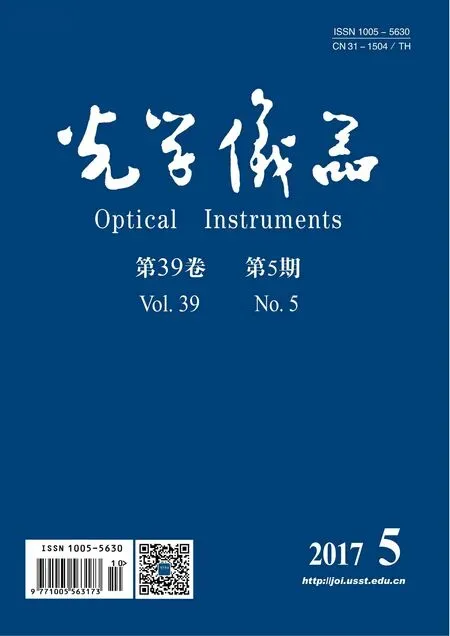Simulation of low light level stress source in low light level night vision system tests
YU Liting, HU Mai
(1.School of Photo-Electronic Engineering, Changchun University of Science and Technology, Changchun 130022, China;2.Hefei Institutes of Physical Science, Chinese Academy of Sciences, Hefei 230031, China)
Simulationoflowlightlevelstresssourceinlowlightlevelnightvisionsystemtests
YU Liting1, HU Mai2
(1.School of Photo-Electronic Engineering, Changchun University of Science and Technology, Changchun 130022, China;2.Hefei Institutes of Physical Science, Chinese Academy of Sciences, Hefei 230031, China)
Aiming at the requirements of the reliability test of low-light-level(LLL) night vision system,it is of great significance to accurately simulate light stress of LLL night vision system under natural conditions in the laboratory.In the wild field,natural LLL is mainly formed by the multiple diffuse reflections of moonlight,starlight and airglow and stray light.Therefore different natural light is formed by different environmental conditions.In the course of the experiment,the illumination of the collimator at the exit pupil is changed and its effect on LLL night vision system is equivalent to that of natural glimmer to simulate different natural LLL.Under experimental conditions,the light pipe field is larger than the field of view of the LLL night vision system,the illumination at exit pupil of parallel light pipes may be changed by changing the light source illumination to achieve the accurate simulation of natural light stress source.The feasibility of this method is verified by experiments.
LLL night vision system; LLL stress source simulation; illumination; parallel light pipe; field of view
Introduction
Low-light-level(LLL) night vision system,following the infrared night vision device,as the focus of the development of night vision technology in the military has gotten rapid development and wide application,for its working in a passive way under the night stars with very low illuminance(10-1~10-4lx)[1].The light weapon shimmer is a night vision sight equipped with light weapons that utilizes the “night light” of nature to allow the shooter to effectively view the target at glimmer conditions at night.LLL night vision system is a powerful magic weapon at night,which has become a great weapon for individual soldier night battles.As an important component of the individual weapon system,LLL gunsight performance condition is highly concerned.As a mechanical and electrical product,its mean time between failures(MTBF) is the key of reliability assessment[2-3].
For example,image intensifier is the core component of an LLL gunsight,which enhances the glimmer to allow people to observe with naked eyes.The sensitive range of typical image intensifier is from 400 nm to 900 nm.In the case of other highly reliable mechanical and optical structures,MTBF of glimmer microscopy depends on the MTBF of image intensifier,and the largest impact on the image intensifier is from light stress[4].Without considering other stress,the mean time between failure(MTBF) of the glimmer and the illuminance received by the photodiode of the image intensifier are in a reciprocal relation within a certain range.
From the above,light stress has a large impact on LLL gunsight,and glimmer at night is the main light source of LLL night vision system to obtain target information.Therefore,during the performance parameter tests on LLL night vision systems,the natural LLL stress source must be simulated to the greatest extent,achieving the standardization and numeralization,which has important significance for actual performance parameter assessment of LLL night vision system.In this paper,a method is presented to realize natural LLL stress source accurately simulated in the laboratory[5].
1 Natural light
1.1Thecharacteristicsofnaturallight
Natural light[6]is generated from moonlight,starlight,airglow and stray light by diffuse reflection through clouds,earth and surrounding terrains,and they are the main light sources of natural light in night sky.These light contains not only visible light,but also much near-infrared light.
The moonlight is formed by the reflection of the moon’s rays,its spectral range is from 0.4~0.7 μm,which is sililar to the sun.In the case of a full moon.The illumination is 2×10-1lx.Airglow is an important component of natural glimmer in the case of no month,the spectral range is from 0.3 μm to 2.2 μm,but in the visible region,the illumination value is weaker than the stars.
In summary,the LLL night vision system to receive the natural light spectrum based on the two cases,a month night and no month night[7].On a moon night,the spectrum range is mainly located from 0.3 μm to 0.7 μm;On no month night,the spectrum range is mainly located from 0.3 μm to 0.9 μm.
Natural light can be seen as a cosine radiator,its characteristics is the luminance in any direction measured at arbitrary points roughly the same,which means the observation point is comparable to be placed at the center of tremendous glowing sphere with uniform luminance,as shown in figure 1.

Fig.1 Schematic diagram of observation point
1.2EffectofnaturallightonLLLgunsights
We can observe a certain spatial angle range with the LLL gunsught,this certain spatial range is represented by the field of view.The light in the field of view can enter the low-light sight and be image on the photocathode cathode surface of the image intensifier,and the glimmer outside the field of view can not reach[8].
2 Simulation of natural LLL stress source
According to 1.2,the effect of LLL gunsight is only from the natural light within the field angle and the field angle of LLL gunsight is generally small,therefore natural light can be simulated by using large-aperture parallel light pipe with uniform luminance in the laboratory and the simulated light has equivalent effect to natural light.LLL test system structure diagram is shown in the figure 2.
When measuring the illumination in some direction,with an illuminometer,the illumination generated from the light source in the range of about 2π solid angle on its front is measured.According to the characteristics of natural light,the light source is a sphere whose radius isR(Rmax) and its brightness isLwith the measuring point as the center[9].
As shown in figure 3,the area of surfacePof illuminometer isA,and the integral surface is the hemisphere ofR(Ris much larger than the diameter ofP) from the center of the object mirror,thus the annular differential element between angle and angle fromPcan be regarded as a rectangle that the length is the circumference of the circle with angle from surfacePand the width is the chord length of corresponding angle,the differential elements area is:
ds=(2πR·sinα)×(R·dα)=2πR2sinαdα
(1)

Fig.2 LLL test system structure system structure diagram

Fig.3 Schematic diagram of light energy radiation
Thus,the luminous flux generated on the illuminometer surface by the area source of such differential element:

(2)
The irradiation angle of natural light for illuminated surface is 2π solid angle on its front,i.e.the integral angleαis from 0 to π/2,therefore the luminous flux generated on the illuminated surface by the sphere with luminance ofLis:

(3)
The illuminance of corresponding natural light is:

(4)
Similar to the measurement of light intensity with illuminometer,the luminous flux received on the illuminated surface by LLL microscopy in the natural environment is:

(5)
In formula(5),2βis the field angle of LLL microscopy,thus the illuminance generated on illuminated surface of LLL microscopy by natural glimmer is:

(6)
By equation(4),we can get:

(7)
When simulating natural light with a collimator,if the field angle of parallel light pipe is 2θ,the illumination generated on the illuminated surface of LLL gunsight’s objective lens:

(8)
Lp—Luminance at the exit of collimator;
Ep—Illuminance at exit of collimator.
Light through the frosted glass,small integral ball,the ball is integral to diffuse reflection and radiation by cosine distribution,the light exit ofMis approximately qual to the brightness of theEillumination.The light intensity does not change with the direction,and has the following relations with the light emission degree and the light intensity:
M=E=πL
(9)
There will be light loss when the light passes through the collimator in the integrating sphere.The main reason for the loss of light energy is the reflection and absorption of the optical energy loss.When the light tube is designed,it can enhance the projection ability of the light by coating the film on the dividing and the light tube lens,so the absorption and reflection of the light in the light tube can be rarely seen.Under the condition of no absorption,we can get the relation between the light intensity at the exit of the large integral sphere and the light intensity at the exit pupil of the light tube:
LS=LP
(10)
By formula (8),(9) and (10) we can get:

(11)
Ls—Luminance at the exit of the large integral sphere;
Es—Illuminance at the exit of the large integral sphere.
According to this relationship,we can simulate the natural light with the illuminance ofEwith the help of the parallel light pipe with view angle of 2θ(2θis greater than 2β) and illumination ofEA=E1at exit pupil.
3 Characteristics of simulated LLL stress source
3.1Simulatedglimmerhassingleparameter
From formula (11),in the simulated specific natural glimmer illumination,the illuminanceEAat exit pupil of parallel light pipe is solely determined by the field angle of the parallel light pipe itself and the illuminance at the exit of large integrating sphere has nothing to do with the differences of test objects.Therefore,for the simulation of different illuminance of natural light,without changing the parallel light pipe’s field angle,the illuminationEof parallel light pipe is the only parameter that needs changing.
3.2DeterminationofsimulatedLLLparameters
By comparing Formula (6) and Formula (8),it shows that whenθ>β,the effective illumination of simulated LLL entering LLL microscope:
EV=sin2(β)Es
(12)
whenθ>β,the effective illumination of simulated glimmer entering LLL microscope:
EV=sin2(θ)Es
(13)
Therefore,in actual measurement the field angle of the parallel light pipe must be larger than that of the measured LLL microscope.Through the statistics and analysis of the magnitude of existing field angle,it is determined that 2θmust be greater than 10 degrees.
3.3SimulatedglimmerisapplicabletoallkindsofLLLmicroscope
Different types of LLL microscopes have different characteristics,such as the fixed focus or zoom lens,etc..So it requires the distance from the target provided to be larger than the minimum observation distance of LLL microscope,so for different light microscopes,the glimmer simulated by all parallel light pipes is applicable.Because the device of simulated glimmer is parallel light pipe,set a reticle as the target to provide for LLL microscopy in its focal plane,which is equal to the target at infinity,meeting the requirement that the distance between the target and LLL microscope must be greater than the minimum distance of observation.
3.4Opticalstressofsimulatedglimmerisslightlygreaterthanthatofnaturallight
In theory,when the optical stress of glimmer simulated by the parallel light pipe and that of natural LLL project on the LLL gunsight,if the light illumations of them are same,their effects are same on sighting telescopes[10].Generally,projection on objective lens of LLL gunsight,the former emit parallel light,as shown in figure 4;and the latter emit divergent light,as shown in figure 5,the light illuminates through objective lens on the receiving surface(image intensifier),they have different effects on light receiving surface,therefore there’s some deviation in the simulation of natural glimmer using parallel light pipes.
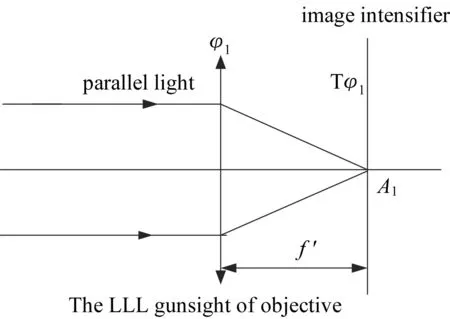
Fig.4 Schematic diagram of parallel light pipe effect

Fig.5 Schematic diagram of natural LLL effect
After the light going through LLL gunsight lens,there will be optical energy loss,which has mainly two factors:① reflection loss of projection plane;② absorption loss of projective material.
(1) The reflection loss of the projection plane:set the number ofKfor the refractive surface,Rfor the reflectivity,Tfor the transmittance.According to the actual situation,if takingK=14,R=1%,
T1=(1-R)K=(1-1%)14=0.898 7
(14)
T1—the sum of transmittance remove from reflection loss.
(2) Absorption loss of projection material:setαas absorptivity,∑das the sum of the center thickness of the projection materials.Takeα=0.015,∑d=3 cm,so:
T2=(1-α)∑d=(1-0.015)3=0.956
(15)
T2—the sum of transmittance remove from absorption loss.
Therefore,the total transmission rate is:
T=T1T2=0.898 7×0.956=0.859
(16)
Φ=TΦ1
(17)
As shown in figure 3 and 4,the luminous flux arriving at image intensifier isΦ,the effects of parallel light and divergent light are different,because the surface areas of projected light spots on image intensifierA1,A2are different.According to formulaE=Φ/A,the illuminanceEis inversely proportional to the surface areaAof projection light spot.
As shown in figure 6,the projection light spot size formed by the parallel light action is:

(18)

Fig.6 Optical pathway diagram of parallel light pipe effect
As shown in figure 7,the natural light effect on the formation of the projected spot size:
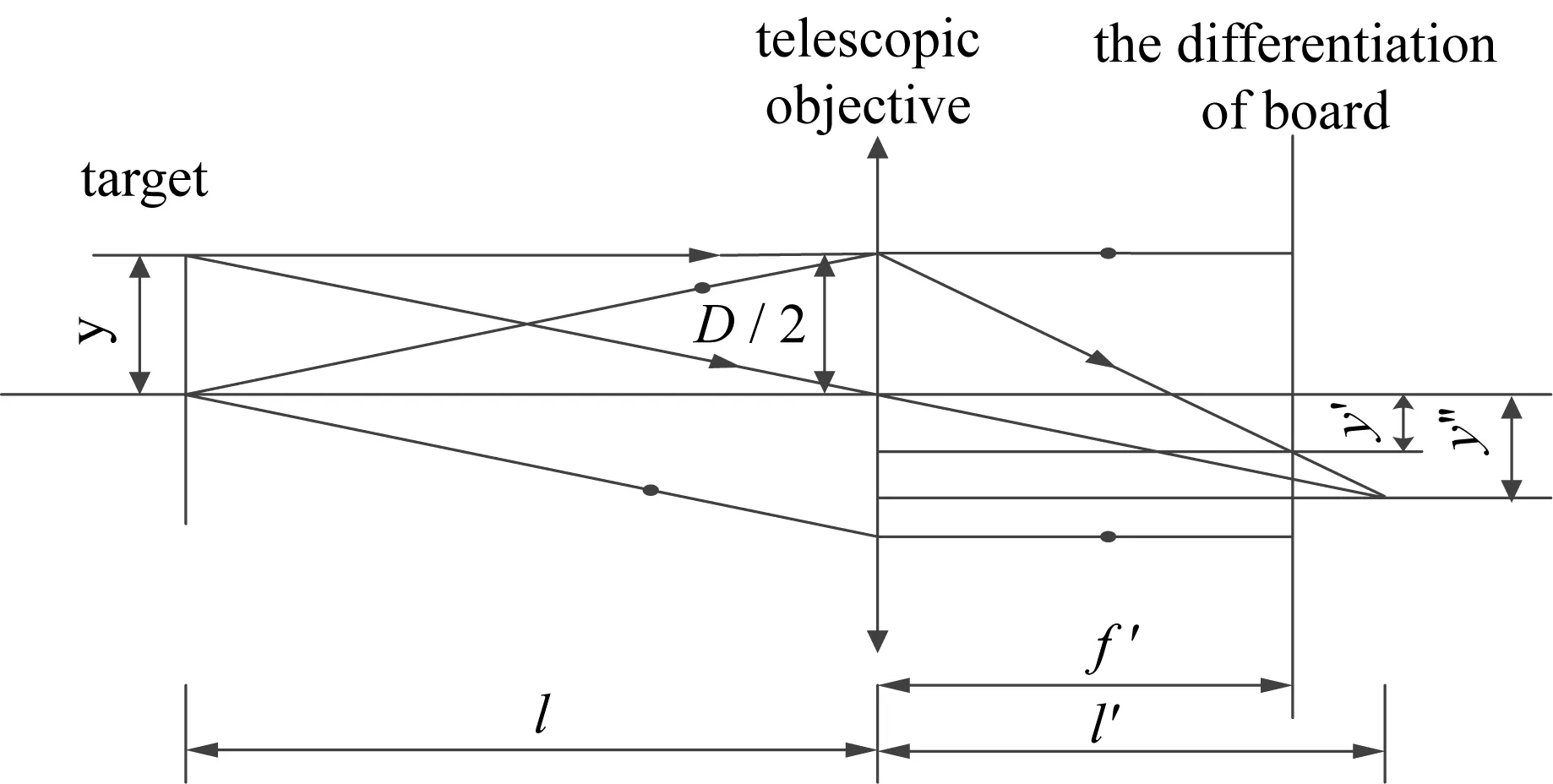
Fig.7 Schematic diagram of natural LLL effect
By Gauss formula:

(19)
And similar triangles:
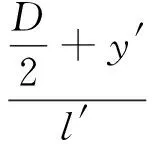
(20)
We can get:

(21)
By comparison of formula (18),(19),regard the image as a square with side length ofy′,y″,we can getA1 3.5Experimentaltestanddataprocessing At night the sky can be divided into months and months of the situation,below we will have several typical weather conditions for laboratory simulation experiments[11].Table 1 lists the approximate values of the illumination of the ground surface under several typical weather conditions.In order to make the laboratory simulation of night light days and the nature of the real value is closer,we conducted a number of field measurements at the same spot under different weather conditions at night sky illumination,and the use of LLL gunsight were observed.Table 2 lists the real values of the illumination of the ground surface under several typical weather conditions. Because of the existence of the village,which is not far from the measurement site,the measured value is slightly higher than the theoretical value. Tab.1 Approximate values of ground background illumination in the several typical weather conditions Tab.2 Real value of ground background illumination in the several typical weather conditions As shown in figure 8,the experimental system consists of light source,integrating sphere,parallel light tube,weak light meter and stabilized power supply etc. Illuminance meter using Hangzhou distance PHOTO-2000U;Measurement range is 1×10-6~9 lx;Measurement accuracy is 1×10-6lx,figure 9 is the physical drawing of illuminometer: Light source is composed of bromine tungsten lamp(12 V,75 W),integrating sphere and stabilized power supply.Bromine tungsten lamp color temperature is 3 200 K;Two integral ball has a uniform light illumination and weaken the effect on light,equipped with adjustable diaphragm at the connection between the light source and the integrating sphere.In order to eliminate or reduce the load resistance and the temperature changes of the output current,the light source adopts constant current power supply[12].Parallel light tube uses the objective lens focal length 600 mm,the field of view angle 10 degrees,the diameter 120 mm big diameter parallel light tube. Fig.8 The physical composition of the LLL stress source test system Fig.9 Physical diagram of the LLL illuminometer During the measurement,the illuminometer is placed at the exit of the large integrating sphere,by adjusting the constant current power supply to control the luminance of bromine tungsten lamp so that the illumination at the exit of the large integrating sphereEsis equal to the corresponding theoretical values in table 1.At the exit of parallel light tube,5 points were randomly selected to measure and record the illumination value[13].Then,the illumination meter was placed in the parallel light tube exit pupil to observe the pupil’s illumination.If the measured illumination value at the exit of parallel light pipe isEAcorresponding to the theoretical value derived by formula (11),it is indicated that the simulation of natural glimmer is reasonable.Table 3 to table 5 are the illumination values measured under several typical weather conditions. Tab.3 Illumination value under simulated full-moon and sunny condition Tab.4 Illumination values under simulated full-moon condition with light clouds Tab.5 Illumination values under simulated half-moon and sunny condition Table 3 to table 5 shows that the experimental measurement data is consistent with the theoretical value of the formula,the experimental system can realize the accurate simulation of the typical night sky. Compared to traditional simulation environment tests,the parallel light pipe is used to simulate natural light,in which the method is simple,parameters can be easily determined,the equipment fabrication is not complicated,the simulation has high precision,and it saves the expenditure compared with the darkroom simulation,because most night vision sighting telescopes belong to the telescope system and their imaging distance is relatively longer,which is more suitable for large darkroom or the field.However,for the construction of a darkroom with a length up to a few hundred meters and equipped with other facilities,the expenditure is very high,and the external conditions for field measurements are very difficult to control.At this stage,there is little information that comprehensively reflects the LLL stress source simulation.Therefore,for the detection of LLL night vision system should study the source simulation,still have important meaning for us. [1] WANG J H,JIN W Q,WANG X.General performance evaluation for direct viewing low light level imaging systems based on minimum resolvable contrast[J].Acta Armamentarii,2010,31(2):184-190. [2] GUO H,XIANG S M,TIAN M Q.A review of the development of low-light night vision technology[J].Infrared Technology,2013,35(2):63-68. [3] JIN W Q,GAO Z Y,SU X G,et al.On the problem of matching between optoelectronics imaging system and human vision[J].Infrared Technology,2000,22(5):40-44. [4] LIU L,LI Y,QIAN Y S,et al.New method for visual range evaluation and scene simulation of low-light-level(LLL) night vision systems[J].Journal of Applied Optics,2006,27(6):546-551. [5] YANG L.Study on the low-light level stress source system of low-light level night vision device testing equipment[D].Changchun:Changchun University of Science and Technology,2014. [6] YE Y L,WU X R.Simulation of low-light-level condition in laboratory[J].Laser & Infrared,2005,35(12):942-943. [7] SHI J F,LIU Y.Night sky radiation simulation for test of low-level-light night vistion systems[J].Journal of Applied Optics,2003,24(5):11-13. [8] SU M K,GAO Z Y,KANG J J.The infection of surroundings illuminate on low-light-level night-vision device[J].Laser & Infrared,2003,33(4):313-315. [9] DRIGGERS R G,JACOBS E L,VOLLMERHAUSEN R H.Current infrared target acquisition approach for military sensor design and wargaming[J].Proceedings of SPIE,2006,6207:620709. [10] BAI L F,QIAN W X,ZHANG Y,et al.Analysis and study on the stadia of low light level imaging system[C]∥Proceedings Volume 5633,Advanced Materials and Devices for Sensing and ImagingⅡ.Beijing,China:SPIE,2015. [11] GABER L.Optical sight system with wide range of shooting distances:US,US6487809B1[P].2002-12-03. [12] SU C Z,CAO G H,XU H J.Relationship analysis of output illuminance of integrating sphere and incident beam geometry[J].Laser & Infrared,2010,40(2):195-199. [13] YU Q S,AN Z Y,YANG R N,et al.Test of Parallax parameters for optoelectronic sights in small arms[J].Optics and Precision Engineering,2010,18(8):1732-1737. 1005-5630(2017)05-0078-09 2016-10-30 吉林省重大专项(20100610);吉林省科技发展计划(20080331、20090555) 于丽婷(1989—),女,硕士研究生,主要从事精密测控技术与仪器方面的研究。E-mail:yuliting456@163.com 胡 迈(1988—),男,助理研究员,主要从事光学精密仪器方向的研究。E-mail:humai1111@163.com 微光夜视系统试验中微光应力源的模拟 于丽婷1, 胡 迈2 (1.长春理工大学 光电工程学院, 吉林 长春 130022;2.中国科学院 合肥物质科学研究院, 安徽 合肥 230031) 针对微光夜视系统可靠性试验的需要,在实验室准确模拟微光夜视系统在自然条件下所受的光应力具有重大意义。野外自然微光主要由月光、星光、大气辉光及杂散光经多次漫反射而成,所以在不同的环境条件下形成的自然微光不同。为模拟出不同的微光应力源,在试验过程中需要改变平行光管出瞳处的光照度,并使其对微光夜视系统的作用与自然微光对微光夜视系统的作用相当。在实验室条件下,当平行光管的视场大于微光夜视系统的视场时,通过改变光源光照度的办法即可改变平行光管出瞳处的光照度,从而实现自然微光应力源的精确模拟,并通过实验验证了该方法的可行性。 微光夜视系统; 微光应力源模拟; 光照度; 平行光管; 视场 TG 156 A 10.3969/j.issn.1005-5630.2017.05.014 by objective lens of LLL microscope isΦ1=sin2(β)πLA,therefore,the luminous flux arriving at image intensifier is: (编辑:张磊)
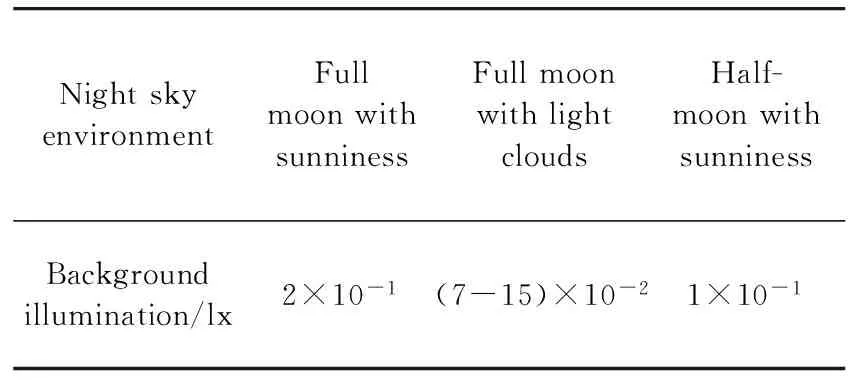
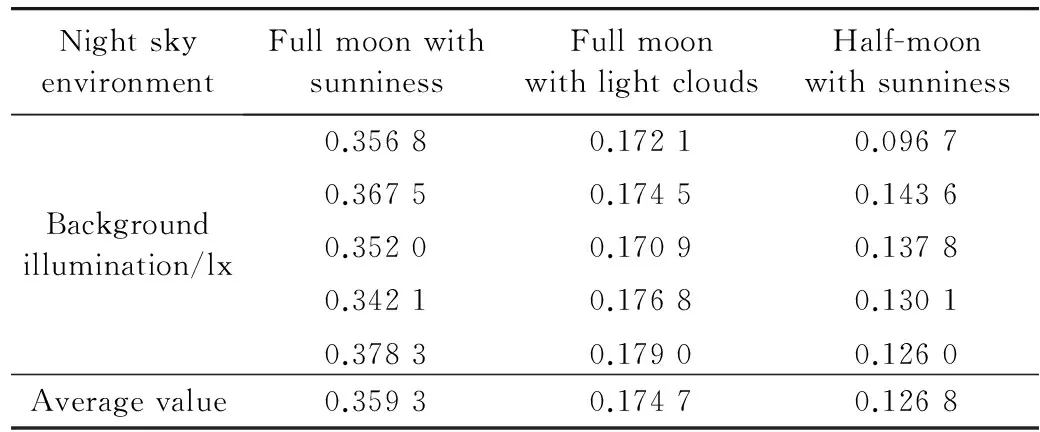

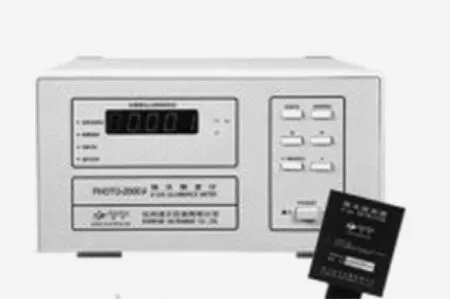
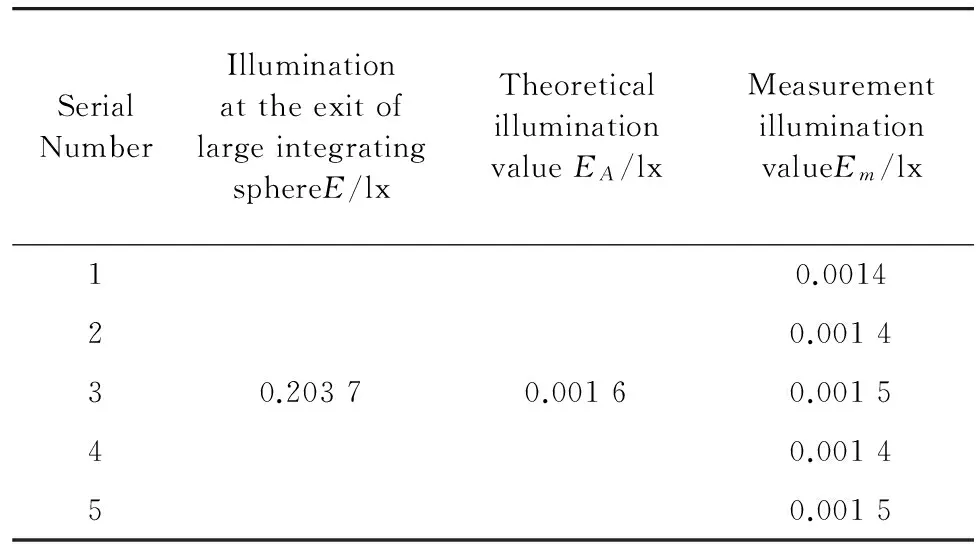


4 Conclusions

